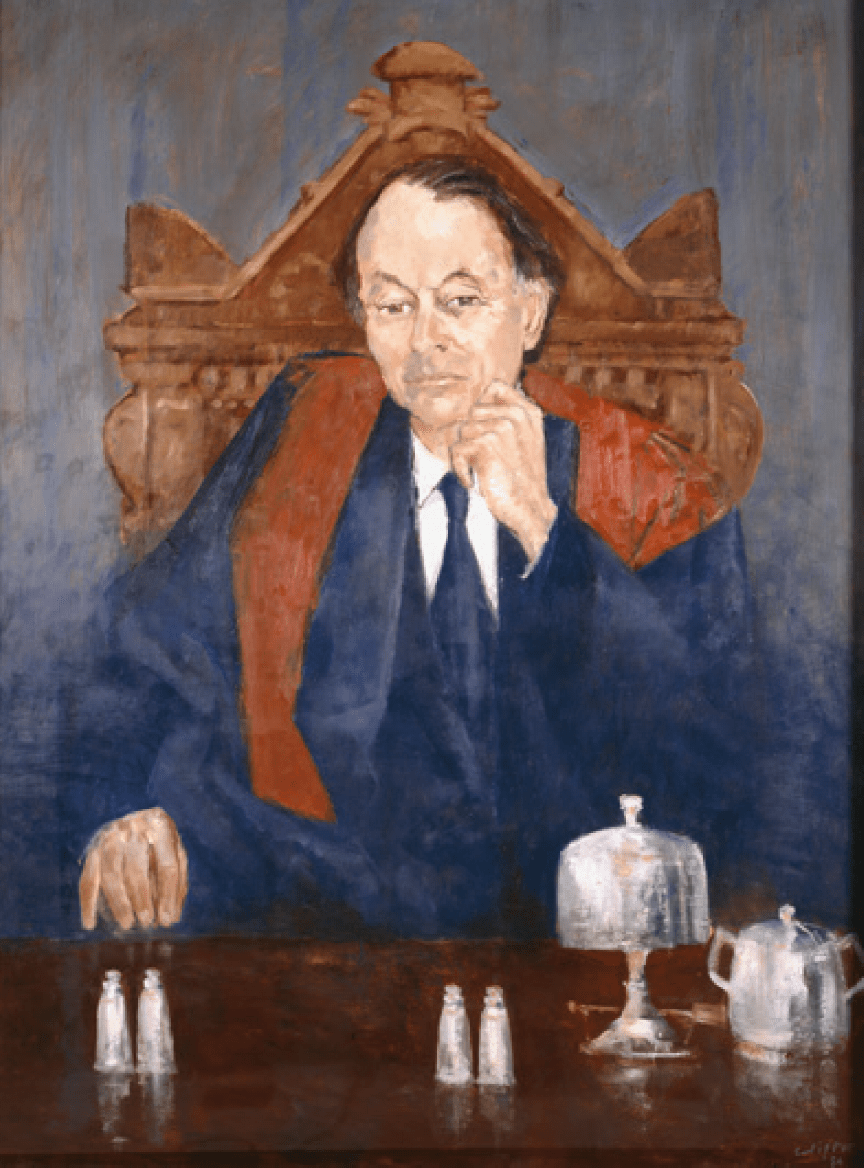The Masters
Rev. Edward Holdsworth Sugden
First Master, Queen’s College, 1888–1928
As Master of Queen’s for 40 years, Dr Sugden played a pivotal role in determining the physical shape of the college and the development of a distinctive College culture. Sugden was a Wesleyan minister, theologian, classicist and noted Shakespearean scholar.
This portrait shows the College’s first Master, the Rev. E.H. Sugden (1854-1935) seated in the chair reserved for the Master in the College Chapel. The portrait was commissioned by the students’ club using monies raised from past and present students, and was presented to the Rev. Sugden on Foundation Day, 1909. Rev. Sugden gave the portrait to Queen’s College as part of the College’s 21st birthday celebrations.
Rev. Frederick Walwyn Kernick
Second Master, Queen’s College, 1929–1933
The Rev. F. Walwyn Kernick (1882-1933) was an English circuit minister and Oxford scholar.
This portrait was painted from photographs many years after Rev. Kernick’s early death from cancer. The commissioning of the portrait was facilitated by former Queen’s students and theological students.
Dr Raynor Carey Johnson
Third Master, Queen’s College, 1934–1964
A Yorkshireman by birth, Dr Johnson (1901-1987) was a physicist and leading research scientist in the field of spectroscopy. In later years Dr Johnson became interested in paranormal phenomena and published many books based on his research into psychical experiences, eastern religions and mysticism. He is shown in this portrait wearing the academic robes of the Doctor of Science conferred on him by the University of London in 1927.
Dr Johnson’s legacy is a complex one. It includes a period of strong contribution to the College over many years, where he played a significant role in opening up opportunities to a more diverse range of residents, the establishment of St Hilda’s College and securing Commonwealth funding for the new residential wing. However, it also includes his involvement a sect known as ‘The Family’ both in the later years of his term as Master and subsequent to him concluding his time as Master of Queen’s. The sect was involved in the adoption of young children in the late 1960s and early 1970s and the children were subjected to severe mistreatment by members of the sect. While there is no evidence that Dr Johnson was involved in the mistreatment, it is clear that he lent legitimacy to the sect and played a key role in its formation and ongoing activities, and on at least one occasion was its public defender. In 2023, Queen’s College Council resolved to re-name a residential building that was named after Dr Johnson in 1960. Council also reiterated their condemnation of Johnson’s involvement in the sect and their expression of profound sympathy to the survivors of the sect and their families.
A link to the letter informing the community of Council’s decision can be found here.
Dr Owen Parnaby
Fourth Master, Queen’s College, 1966–1986
A former student and tutor at Queen’s, Dr Owen Parnaby (1921-2007) was the first Wyvern to become Master of the College. Appointed during a period of great social change, Dr Parnaby’s mastership was notable for the introduction of co-residence for female students in 1973. An historian by training, Dr Parnaby wrote ‘Queen’s College. University of Melbourne. A Centenary History‘ to celebrate the College’s first 100 years. This portrait shows him in academic dress, seated in the Master’s Chair at High Table.
Dr George Anderson Macdonald Scott
Fifth Master, Queen’s College, 1986–1992
A Scotsman by birth, Dr Scott’s (1933-1998) portrait shows him in customary kilt and sporran, wearing the academic gown of the Doctor of Science conferred on him by the University of Melbourne in 1990. Dr Scott is depicted in an Australian landscape, reflecting his love of the outdoors and his academic interests as a botanist.
Rev. Dr John Henley
Sixth Master, Queen’s College, 1993–2001
An ethicist and minister of the Uniting Church in Australia, the Rev. Dr. Henley (1940- ) was the first ordained minister to be appointed to the mastership of Queen’s College since the Rev. Kernick, in 1929. Dr Henley is depicted in his characteristically contemplative pose in the College Close with its distinctive green lawns and hedge.
Professor David Runia
Seventh Master, Queen’s College, 2002–2016
Professor Runia (1951- ) is the second Wyvern to be appointed Master of Queen’s College. He is shown in this portrait standing at the lectern in Eakins Hall, wearing the academic robes of the Doctor of Letters conferred on him by the University of Melbourne in 2003. In the background, a number of words in ancient Greek represent his academic interests. The words are horizontally ΚΟΣΜΟΣ (cosmos) and ΘΕΟΣ (God, partly hidden), vertically ΦΙΛΩΝ (Philo) and ΝΟΥΣ (mind), key terms in ancient Greek cosmology and including the name of the author that has been the chief focus of his research. The Master’s role as head of the College is symbolised by the lectern with the College’s coat of arms, in which the Wyvern is prominent as its crest. He also wears a Wyvern tie and on the fourth finger of his lefthand the Master’s signet ring.







